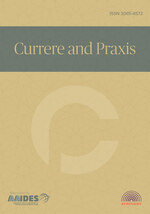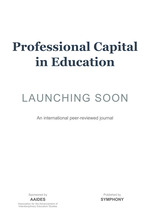Equity and excellence in English language education in the USA: A literature review from the 1960s to 2020s
DOI:
https://doi.org/10.70116/2980274115Keywords:
Funds of Knowledge (FoK), Language architects, Racial, linguistic, and cultural repertoires, Racialized attitudesAbstract
This study examined the trends in English language education (ELE) using a literature review from the 1960s to the 2020s as a research method. After reading the 1012 journal article abstracts, 210 articles emerged using the 37 keywords, which were supposed to embrace racial and linguistic equity. After multiple iterations of reading and open coding these abstracts, thirty-two articles were selected for the final analysis. One research question guided this study, “What were the emerging trends of PK-12 ELE in the USA in terms of equity and excellence from the 1960s to the 2020s?” Three phases were identified: Phase 1 (1968-1999) on remedial service; Phase 2 (2000-2007) on test accountability; and Phase 3 (2008-2020) on asset-based ELE. We integrated Feiman-Nemser’s central tasks into the four themes: 1) gaining EBLs' funds of knowledge (FoK), 2) enacting EBLs' racial, linguistic, and cultural repertoires, 3) forming teacher beliefs, and 4) deepening knowledge of the curriculum. The findings revealed shifts in three phases under each theme: from assimilating to the target language and culture and devaluing EBLs' assets in Phase 1 to interweaving EBLs’ FoK but with racialized attitude towards EBLs in Phase 2 and valuing EBLs’ FoK as assets, seeing them as ‘language architect’, and integrating translanguaging and resisting raciolinguistic ideologies into ELE in Phase 3.
Downloads
References
Auerbach, E. R. (1993). Reexamining English only in the ESL classroom. TESOL Quarterly, 27(1), 9-32. https://doi.org/10.2307/3586949
Bankston, C. L., & Zhou, M. (1995). Effects of minority-language literacy on the academic achievement of Vietnamese youths in New Orleans. Sociology of Education, 68(1), 1-17. https://doi.org/10.2307/2112760
Barker, G. (1947). Social functions of language in a Mexican American community. Acta Americana, 4, 189–192.
Baron, D. E. (1990). The English-only question: An official language for Americans? Yale University Press.
Blanton, C. K. (2005). The strange career of bilingual education in Texas, 1836—1981. Texas A&M University Press.
Brown, T. S., & Perry, F. L. (1991). A comparison of three learning strategies for ESL vocabulary acquisition. TESOL Quarterly, 25(4), 655-670. https://doi.org/10.2307/3587081
Callahan, R., Wilkinson, L., & Muller, C. (2010). Academic achievement and course taking among language minority youth in U.S. schools: Effects of ESL placement. Educational Evaluation and Policy Analysis, 32(1), 84–117. https://doi.org/10.3102/0162373709359805
Carranza, M. A., & Bouchard Ryan, E. (1975). Evaluative reactions of bilingual Anglo and Mexican American adolescents toward speakers of English and Spanish. International Journal of the Sociology of Language, 1975(6), 83-104. https://doi.org/10.1515/ijsl.1975.6.83
Charmaz, K. (2014). Constructing grounded theory: A practical guide through qualitative analysis (2nd ed.). Sage.
Chularut, P., & DeBacker, T. K. (2004). The influence of concept mapping on achievement, self-regulation, and self-efficacy in students of English as a second language. Contemporary Educational Psychology, 29(3), 248–263. https://doi.org/10.1016/j.cedpsych.2003.09.001
Cohen, A. D., & Swain, M. (1976). Bilingual education: The “immersion” model in the North American context. TESOL Quarterly, 10(1), 45-53. https://doi.org/10.2307/3585938
Collier, V. P. (1987). Age and rate of acquisition of the second language for academic purposes. TESOL Quarterly, 21(4), 617-641. https://doi.org/10.2307/3586986
Crawford, J. (1991). Bilingual education: History, politics, theory, and practice (2nd ed.). Bilingual Educational Services.
Daniels, H. (Ed.). (1990). Not only English: Affirming America’s multilingual heritage. National Council of Teachers of English.
De Jong, E., & Howard, E. (2009). Integration in two-way immersion education: Equalizing linguistic benefits for all students. International Journal of Bilingual Education and Bilingualism, 12(1), 81–99. https://doi.org/10.1080/13670050802149531
Escamilla, K. (2006). Semilingualism applied to the literacy behaviors of Spanish-speaking emerging bilinguals: Bi-illiteracy or emerging biliteracy? Teachers College Record, 108(11), 2329–2353. https://doi.org/10.1111/j.1467-9620.2006.00784.x
ESSA. (2015). S.1177 - Every Student Succeeds Act (ESSA). Retrieved January 3, 2024, from https://www.congress.gov/bill/114th-congress/senate-bill/1177
Evans, B. A., & Hornberger, N. H. (2005). No child left behind: Repealing and unpeeling federal language education policy in the United States. Language Policy, 4(1), 87–106. https://doi.org/10.1007/s10993-004-6566-2
Fang, F., & Liu, Y. (2020). ‘Using all English is not always meaningful’: Stakeholders’ perspectives on the use of and attitudes towards translanguaging at a Chinese university. Lingua, 247, 102959. https://doi.org/10.1016/j.lingua.2020.102959
Feiman-Nemser, S. (2001). From preparation to practice: Designing a continuum to strengthen and sustain teaching. Teachers College Record, 103(6), 1013–1055. https://doi.org/10.1111/0161-4681.00141
Flores, N. (2017). The specter of semilingualism in the bilingualism of Latino students. Texas Education Review, 5(1), 76–80.
Flores, N. (2020). From academic language to language architecture: Challenging raciolinguistic ideologies in research and practice. Theory Into Practice, 59(1), 22–31. https://doi.org/10.1080/00405841.2019.1665411
Flores, N., & Rosa, J. (2015). Undoing appropriateness: Raciolinguistic ideologies and language diversity in education. Harvard Educational Review, 85(2), 149–171. https://doi.org/10.17763/0017-8055.85.2.149
García, A., & Gaddes, A. (2012). Weaving language and culture: Latina adolescent writers in an after-school writing project. Reading & Writing Quarterly, 28(2), 143–163. https://doi.org/10.1080/10573569.2012.651076
Gunn, B., Biglan, A., Smolkowski, K., & Ary, D. (2000). The efficacy of supplemental instruction in decoding skills for Hispanic and Non-Hispanic students in early elementary school. The Journal of Special Education, 34(2), 90–103. https://doi.org/10.1177/002246690003400204
Han, W. J. (2012). Bilingualism and academic achievement. Child Development, 83(1), 300–321. https://doi.org/10.1111/j.1467-8624.2011.01686.x
Hoover, J. J., & Barletta, L. M. (2016). Special education assessment of ELs. In J. J. Hoover, L. M. Baca, & J. K. Klingner (Eds.), Why do English learners struggle with reading? Distinguishing language acquisition from learning disabilities (2nd ed., pp. 117-139). Corwin.
Hoover, J. J., & deBettencourt, L. U. (2018). Educating culturally and linguistically diverse exceptional learners: The need for continued advocacy. Exceptionality, 26(3), 176–189. https://doi.org/10.1080/09362835.2017.1299530
Hornberger, N. H., & Link, H. (2012). Translanguaging in today’s classrooms: A biliteracy lens. Theory Into Practice, 51(4), 239–247. https://doi.org/10.1080/00405841.2012.726051
Jiménez, R. T. (2000). Literacy and the identity development of Latina/o students. American Educational Research Journal, 37(4), 971–1000. https://doi.org/10.3102/00028312037004971
Johnson, E. J. (2012). Arbitrating repression: Language policy and education in Arizona. Language and Education, 26(1), 53–76. https://doi.org/10.1080/09500782.2011.615936
Johnson, K. E. (1992). The relationship between teachers’ beliefs and practices during literacy instruction for non-native speakers of English. Journal of Reading Behavior, 24(1), 83–108. https://doi.org/10.1080/10862969209547763
Keis, R. (2006). From principle to practice: Using children’s literacy to promote dialogue and facilitate the “coming to voice” in a rural Latino community. Multicultural Perspectives, 8(1), 13-19. https://doi.org/10.1207/s15327892mcp0801_3
Kieffer, M. J., Lesaux, N. K., & Snow, C. E. (2008). Promises and pitfalls: Implications of NCLB for identifying, assessing, and educating English language learners. In G. L. Sunderman (Ed.), Holding NCLB accountable: Achieving, accountability, equity, & school reform (pp. 57–74). Corwin Press.
Kim, Y. G. (2020). Toward integrative reading science: The direct and indirect effects model of reading. Journal of Learning Disabilities, 53(6), 1-23. https://doi.org/10.1177/0022219420908239
KM+ (n.d.). Knowledge Matrix plus for supporting scientometric. Retrieved December 22, 2023, from http://mirian.kisti.re.kr/km/km.jsp
Krear, S. E. (1969). The role of the mother tongue at home and school in the development of bilingualism. ELT Journal, 24(1), 2–4. https://doi.org/10.1093/elt/XXIV.1.2
Kubota, R., & Lin, A. (2006). Race and TESOL: Introduction to concepts and theories. TESOL Quarterly, 40(3), 471-493. https://doi.org/10.2307/40264540
Lewis, G., Jones, B., & Baker, C. (2012). Translanguaging: Developing its conceptualization and contextualization. Educational Research and Evaluation, 18(7), 655–670. https://doi.org/10.1080/13803611.2012.718490
Li, W. (2011). Moment analysis and translanguaging space: Discursive construction of identities by multilingual Chinese youth in Britain. Journal of Pragmatics, 43(5), 1222–1235. https://doi.org/10.1016/j.pragma.2010.07.035
Li, W. (2018). Translanguaging as a practical theory of language. Applied Linguistics, 39(1), 9–30. https://doi.org/10.1093/applin/amx039
Lucas, T., Strom, K., Bratkovich, M., & Wnuk, J. (2018). Inservice preparation for mainstream teachers of English language learners: A review of the empirical literature. The Educational Forum, 82(2), 156-173. https://doi.org/10.1080/00131725.2018.1420852
Luykx, A., Lee, O., Hart, J., & Deaktor, R. (2007). Cultural and home language influence children’s responses to science assessments. Teaching and Learning, 109(4), 897–926. https://doi.org/10.1177/016146810710900403
Maxwell, L. A. (2012). Momentum builds for dual-language learning. Education Week, 31(26), 16–17.
Mertens, D. (2019). Research and evaluation in education and psychology. Sage.
Moll, L. C., Estrada, E., Diaz, E., & Lopes, L. M. (1980). The organization of bilingual lessons: Implications for schooling. The Quarterly Newsletter of the Laboratory of Comparative Human Cognition, 2(3), 53–58.
Nakano, D., & Muniz, J. (2018). Writing the literature review for empirical papers. Production, 28, e20170086. https://doi.org/10.1590/0103-6513.20170086
NCES. (2022). English language learners in public schools. Retrieved December 9, 2023, from https://nces.ed.gov/programs/coe/indicator/cgf/english-learners
Otheguy, R., García, O., & Reid, W. (2015). Clarifying translanguaging and deconstructing named languages: A perspective from linguistics. Applied Linguistics Review, 6(3), 281–307. https://doi.org/10.1515/applirev-2015-0014
Pacheco, M. B., & Smith, B. E. (2015). Across languages, modes, and identities: Bilingual adolescents’ multimodal code-meshing in the literacy classroom. Bilingual Research Journal, 38(3), 292–312. https://doi.org/10.1080/15235882.2015.1091051
Peercy, M. (2011). Preparing English language learners for the mainstream: Academic language and literacy practices in two junior high school ESL classrooms. Reading & Writing Quarterly, 27(4), 324–362. https://doi.org/10.1080/10573569.2011.596105
Phillipson, R. (1988). Linguicism: Structures and ideologies in linguistic imperialism. In T. Skutnabb-Kangas & J. Cummins (Eds.), Minority education: From struggle to shame (pp. 339–358). Multilingual Matters.
Phillipson, R. (1992). Linguistic imperialism. Oxford University Press.
Popay, J., Roberts, H., Sowden, A., Petticrew, M., Arai, L., Rogers, M., & Duffy, S. (2006). Guidance on the conduct of narrative synthesis in systemic reviews. A product from the ESRC methods programme version, 1, b92.
Reeves, J. R. (2006). Secondary teachers’ attitudes toward including English language learners in mainstream classrooms. Journal of Educational Research, 99(3), 131–142. https://doi.org/10.3200/joer.99.3.131-143
Ricento, T. (2005). Problems with the “language-as-resource” discourse in the promotion of heritage languages in the U.S.A. Journal of Sociolinguistics, 9(3), 348–368. https://doi.org/10.1111/j.1360-6441.2005.00296.x
Rossell, C. H., & Baker, K. (1996). The educational effectiveness of bilingual education. Research in the Teaching of English, 30(2), 7–74.
Schumann, J. H. (1986). Research on the acculturation model for second language acquisition. Journal of Multilingual and Multicultural Development, 7(5), 379–392. https://doi.org/10.1080/01434632.1986.9994254
Short, D., Echevarría, J., & Richards-Tutor, C. (2011). Research on academic literacy development in sheltered instruction classrooms. Language Teaching Research, 15(3), 363-380. https://doi.org/10.1177/1362168811401155
Snyder, H. (2019, October). Literature review as a research methodology: An overview and guidelines. A Journal of Business Research, 104, 333-339. https://doi.org/10.1016/j.jbusres.2019.07.039
Song, K. (2016). Systematic professional development training and its impact on teachers’ attitudes toward ELLs: SIOP and guided coaching. TESOL Journal, 7(4), 767-799. https://doi.org/10.1002/tesj.240
Stewner-Manzanares, G. (1988). The Bilingual Education Act: Twenty years later. New Focus, 6, 1–8.
Tong, F., Lara-Alecio, R., Irby, B., Mathes, P., & Kwok, O. (2008). Accelerating early academic oral English development in transitional bilingual and structured English immersion programs. American Educational Research Journal, 45(4), 1011–1044. https://doi.org/10.3102/0002831208320790
Torraco, R. J. (2005). Writing integrative literature reviews: Guidelines and examples. Human Resource Development Review, 4(3), 356-367. http://dx.doi.org/10.1177/153448430527828
Villegas, A. M., & Lucas, T. (2002). Educating culturally responsive teachers: A coherent approach. State University of New York Press.
Villegas, A.M., SaizdeLaMora, K., Martin, A.D., & Mills, T. (2018). Preparing future mainstream teachers to teach English language learners: A review of the empirical literature. The Educational Forum, 82(2), 138–155. https://doi.org/10.1080/00131725.2018.1420850
Downloads
Published
How to Cite
Issue
Section
License
Copyright (c) 2024 Symphony

This work is licensed under a Creative Commons Attribution 4.0 International License.














